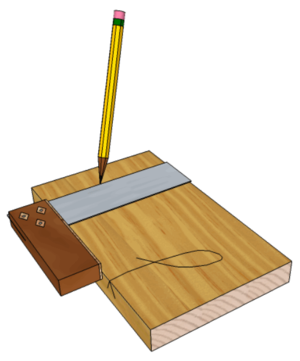Face Side and Face Edge: Difference between revisions
From DT Online
(Created Article) |
mNo edit summary |
||
| (2 intermediate revisions by the same user not shown) | |||
| Line 1: | Line 1: | ||
[[File:MarkingSquareLine.png|300px|right]] | [[File:MarkingSquareLine.png|300px|right]] | ||
__TOC__ | |||
=====Description===== | |||
Modern timber is machined to a high degree of accuracy but this was not always the case. Even now, a length of timber might have one edge which has been cut straight and another which still retains the outside shape of the tree - known as a '''Waney Edge'''. | Modern timber is machined to a high degree of accuracy but this was not always the case. Even now, a length of timber might have one edge which has been cut straight and another which still retains the outside shape of the tree - known as a '''Waney Edge'''. | ||
| Line 6: | Line 11: | ||
Throughout any subsequent marking and measuring, the '''Face Side''' and '''Face Edge''' are used as the '''Datum Surfaces''' from which all | =====Features and Applications===== | ||
Throughout any subsequent marking and measuring, the '''Face Side''' and '''Face Edge''' are used as the [https://en.wikipedia.org/wiki/Datum_reference '''Datum Surfaces'''] from which all measurements are taken and against which the stock of a tool such as a '''[[Try Square]]''' or '''[[Gauges|Marking Gauge]]''' is pressed. | |||
When marking out joints for a rectangular frame for example, a combination of ensuring '''Face Sides''' are always on top, '''Face Edges''' always on the inside, and the joints numbered, will ensure the frame is always assembled the same way and will be flat on its '''Face Side''' even if the joints are not exactly in the centre of the timber thickness. | |||
---- | ---- | ||
<span style="color: green">'''Note:''' | <span style="color: green">'''Note:''' | ||
| Line 12: | Line 22: | ||
</span> | </span> | ||
---- | ---- | ||
{{Wood Joints Buyers Guide}} | |||
[[Category:Terminology]] | |||
Latest revision as of 08:12, 18 June 2018
Description
Modern timber is machined to a high degree of accuracy but this was not always the case. Even now, a length of timber might have one edge which has been cut straight and another which still retains the outside shape of the tree - known as a Waney Edge.
Good practice when marking out timber therefore is to choose the straightest edge and mark this as the Face Edge. Similarly, select the best or flattest surface and mark this as the Face Side as shown.
Features and Applications
Throughout any subsequent marking and measuring, the Face Side and Face Edge are used as the Datum Surfaces from which all measurements are taken and against which the stock of a tool such as a Try Square or Marking Gauge is pressed.
When marking out joints for a rectangular frame for example, a combination of ensuring Face Sides are always on top, Face Edges always on the inside, and the joints numbered, will ensure the frame is always assembled the same way and will be flat on its Face Side even if the joints are not exactly in the centre of the timber thickness.
Note: Even when Squaring Round (i.e. marking a line all around a piece of timber) a Try Square stock should always be pressed against either the Face Side or Face Edge
- Good tools will last a lifetime - buy the best you can afford!










